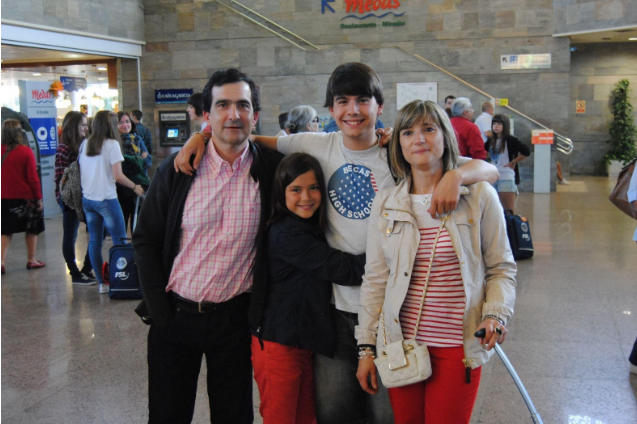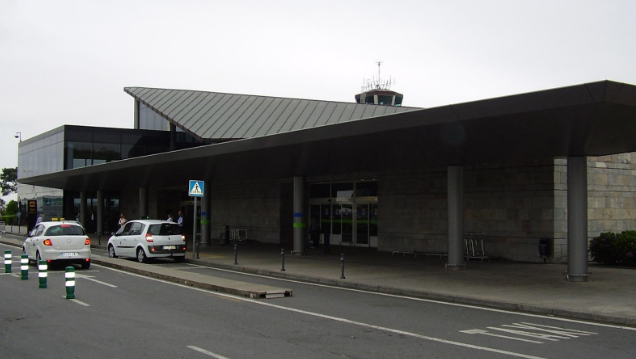Approximately 4,000 miles separate the Spanish coastal city of A Coruña and Lawrenceville, a sleepy, road-filled suburb of Atlanta, Georgia. The two places don’t have much in common. Goose barnacles, octopus, pork raxo and Albariño wine are prominent in the cuisine of Coruña, while in Lawrenceville we enjoy the Southern flavors of fried chicken and sweet tea. As someone raised in Coruña, where winters blend with springs, Lawrenceville’s long summers, boiling above the red-bricked family houses, can feel oppressive. But I didn’t know any of this in August 2011, when I embarked on a journey of many hours from the Alvedro Airport in Coruña, bound for Atlanta’s Hartsfield–Jackson. I was 16, beginning an adventure as a high school exchange student in America.
A family photo shows the author as a teen at the A Coruña airport with his family, about to leave for the US as an exchange student
My sobbing parents waved goodbye from the rectangular slabs of granite on the departures floor. My little sister, who would soon become a teenager, was there too. I wouldn’t see them until the following spring. Georgia would change my life, but crossing through the small security gates, the only thing I wanted was to escape that bus station-like airport and head back to my childhood home.
Alvedro, or LCG A Coruña Airport, is the second busiest airport of the three serving Galicia, the Spanish region where Coruña is located. It opened back in 1963, during a decade of intense infrastructure development that spawned several Spanish airports in places like Asturias and Almería, in response to a surge in tourism. Thanks in part to two consecutive Eurovision victories, Spain slowly became an international destination for sun-seeking Europeans and Americans.

Spain’s 1968 Eurovision winner, “La, la, la” sung by Massiel
Airports were a symbol of progress, a way for Francisco Franco’s dictatorship to whitewash its human rights violations with the promise of endless sun, Mediterranean beaches and paella. The same year Alvedro opened, Julián Griumau, a communist politician, was executed by a military firing squad in Madrid, the capital where Joaquín Delgado Martínez, an anarchist activist, had been killed by garrote vil, a torture mechanism, in 1963.
As the city of Coruña developed during the 60s and 70s, and especially after Spain’s return to democracy in 1975, the airport expanded its infrastructure to accommodate growing traffic. 259,000 passengers flew through its terminal in 1994, the year before I was born, almost 12,000 more people than the city’s current population. The opening of a new terminal the following year brought media attention, and even the then-Socialist Minister of Public Works—and current European Union Representative for Foreign Affairs—Josep Borrell, attended its opening. Watching videos from that time, it feels like little has changed. Four mayors later, there’s still a similar set of greenish plastic seats flanking a dozen counters listing regional flights from Madrid to Barcelona.
The last time I visited Alvedro, my destination was again the United States. This time, however, JFK would be my last stop before reaching home. At around 7:00 a.m. on a cool September morning, I had a refreshing Coca-Cola with my weary-eyed parents at La Pausa, the airport’s cafe. And after several hours wandering around the Adolfo Suárez Madrid-Barajas airport in Madrid, I was back in my Brooklyn apartment in time for dinner at Mekelburg’s, a Clinton Hill bar.
For the more than 2.7 million Spanish citizens living abroad, airports make it easy to come back every time homesickness hits harder than usual. But they’re also escape routes for generations like mine, destined to invest Spain’s public education funding in some foreign country. While I’m very grateful for the life I’ve built here, some of the 30% unemployed youth in Spain have no option but to migrate. Airports like Alvedro pave the way for those in hopes of a better future. Even if it has to be lived abroad.
Source: Wikimedia
I don’t have a solution for these issues, but it seems obvious that investing in an efficient infrastructure system connecting Spain’s regional territories could be a good start. On any given day, it’d be easier to fly the 370 miles separating Coruña from Madrid than to get to Irixoa—the village where my grandma lives, 30 miles away from my hometown—using public transportation. Only around 1,330 people live in Irixoa, it’s true, but, like many parts of Europe, Galicia is a territory made up of small villages with scattered houses and slate-roofed churches. The region owes its citizens reliable public transportation. Instead of allocating millions to airport renovations, local communities could be better served by reliable bus lines and commuter rail services to connect the region’s towns and villages, freeing them from the constraints of cars.

Alvedro isn’t built for farewells. There are no private corners or discreet corridors for a real, lasting hug before boarding. Its central square, between the cafe and the airline counters, is the usual setting where anxious parents ask, yet again, if an extra-large bocata —a sandwich— will be enough. If you ever find yourself departing from Alvedro, you’d have to circumvent several such families before traversing the gift store that connects the terminal with the police security check. You’ll zigzag through rows of regional products such as Bonilla chips while waiting in line, passport in hand.
Unless fog gets in the way, I’ll be landing again in Alvedro sometime in December, ready for family gatherings that last until late at night. Even though I’ve been making the trip for a few years, glimpsing the airport’s concrete track amid the green forest bush before landing still feels like a promise of endless possibilities, a space devoid of the challenges I face in New York, rats included. I’ll just have to pick up my suitcase and wait for the glass sliding doors to release me. Until the next time I have to leave.